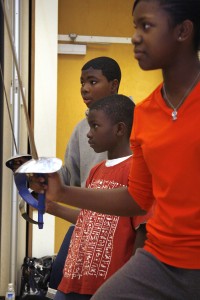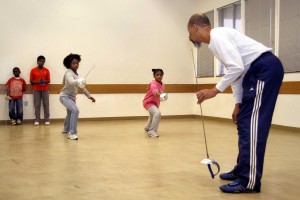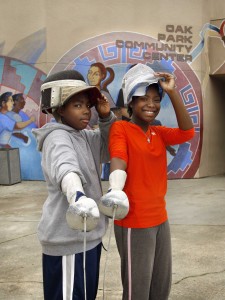Faith and Steel
Posted on February 1, 2010 – 4:15 PM | by OldManFosterBy James W. Cameron photos by Jesse Vasquez

Imani students Myles Mitchell, Malik Hill, and Breeana Johnson
The sound of shuffling feet, soft thuds, and the solid clang and clank of metal on metal dominate an otherwise eerie stillness as the fencers move back and forth, thrusting and parrying in a balletic movement all their own. The action is rapid, fluid, as the fencers advance and retreat, intent on scoring on their opponents and eluding efforts to score on them. The atmosphere is hushed but expectant, rife with excitement.
The scene is the Oak Park Community Center where David Williams and Kathi Johnson, partners who met at City College in 1976, work with young people to introduce them to a regimen unknown to most kids their age – the world of fencing.
“The program was created nine years ago”, explains Williams. “As a black kid growing up in Oak Park and Compton, I didn’t know fencing existed. I bounced around and got in and out of trouble, finally settled down and entered Sac State where I discovered the sport. By my senior year, I made the fencing team.” Johnson also fenced in her youth, and David’s son, Max, followed in their footsteps and was a national champion in saber at an early age.
Williams is a tall, angular and eloquent man whose boundless energy keeps him jumping to his feet and striding back and forth during conversation. He earned both BS and MS degrees at Sac State, then went on to garner teaching and administration credentials. The program he and Johnson created, known as the Imani Fencing Foundation, is the extension of a lifetime spent teaching and mentoring young people.

Malik Hill, Breeana Johnson K-Lynn Blacksher, Camil Blacksher with Coach David Williams
Imani is a Swahili word meaning “faith” and Williams and Johnson have demonstrated their own faith in young people by helping them to better their lives through sport. “This is a non-profit organization,” says Williams. “We’ve never taken a red cent from it… the satisfaction we get from seeing these young people grow is payment enough.” He is quick to share credit. “Others have been helpful. Tom Sumter of the Oak Park Neighborhood Association provided us with two electric scoring machines and the Community Center provides space without charge.”
Instruction is offered three times a week, and on a recent Saturday morning, children and parents were gathered at the Community Center and the program was in full swing. Williams and a protégé were clad in fencing masks and padded doublets, advancing and backing in classic fencing style as other students looked on.

Myles Mitchell and Breeana Johnson
The young man training with Williams is the program’s star, James Giles, age twelve. Giles recently won a gold medal in regional competition and will compete this summer in the two national tournaments held each year. He has been in the program since age six and has consistently faced older opponents because of his skill level. “I love the sport, even when I lose,” he says, “and I lost a lot early because I competed against much older guys… but the competition is wonderful and it all came together for me last year. I started defeating some of the best in California, even outside of my age class. That’s a great feeling.” Williams thinks he has the talent to become a national champion.
Looking on as Williams and Giles evaded one another’s feints were several others waiting for instruction. Erick Romer, a courteous and soft spoken thirteen year old who has been in the program for only a year, spoke of being drawn to fencing because “it looked elegant and I enjoy competition.” He’s been competing in local tournaments and hopes to advance. Aidan Willett, in the program for only six months, and his mother, Stacey, talked of the training in physical fitness that Williams and Johnson insist on- Aidan balances “soccer, basketball and fencing, all sports that I love.” Aidan, like Erick, speaks of the joy of competition and a feeling of accomplishment.
The fencing sword was used as early as the fifth century and was widely utilized for duels in Europe during the Middle Ages, but it wasn’t until the nineteenth century that fencing developed into a sport. Three types of swords are used in modern competition. The foil is a lighter, more flexible version of the Italian rapier and allows competitors to attack from a variety of angles. The epee emerged in France where fencing was more formal and restrained and the epee is a weapon of patient, defensive strategy. The saber is the modern version of the slashing cavalry sword and favors the fencer who attacks first since it permits scoring with the edge of the blade as well as the point. Scoring and tactics are complex, fencers wear body and facial protection, and competition is conducted in a “piste” or fencing strip, an area 14 meters long and 1.8 to two meters wide. The action is dazzling in its speed and intensity.
African Americans became active in fencing in the 1930s. YMCAs and YWCAs provided basic instruction but blacks were generally shut out of competition by the racial discrimination then practiced by the nation’s fencing organizations. African American Violet Barker learned fencing from Alex Hern, a Jew who was teaching the sport at settlement and neighborhood houses throughout New York City in the thirties. Barker subsequently won a WPA recreational league championship, but when she arrived at the New York Fencers Club for an open foil meet, she was barred from competition because of her race. As late as 1949, Columbia University’s varsity fencing team was pressured to withdraw its two black members from competition at the New York Athletic Club and withdrew in protest. But by the early 1950s, African Americans were slowly gaining acceptance by the sport’s governing bodies, and in 1969, Ruth White of New York University became the first black athlete to win a national fencing title. She was quickly followed by others and Peter Westbrook came home from the 1984 Olympic Games in Los Angeles with a bronze medal in the saber. Since then, American fencing has assumed an increasing multiethnic and multiracial appearance.
In nine years, the Imani Fencing Foundation has worked with seven hundred young people and many have benefited from the program’s commitment to good citizenship, racial equality and social responsibility. “Things are improving for African American kids and, hopefully, we’ve been a part of that,” says Williams. “The kids of parents who didn’t complete school in the sixties and seventies have learned from that and are completing their educations. In a similar way, we think that our fencing program teaches kids things about themselves and their ability to handle life’s necessities.” Johnson echoes his comments. “It’s all about the kids and their future”, she says. “They’re more confident as a result of programs like ours and have a better sense of who they are and what they can accomplish. They ‘get it’.”
Tags: David Williams, Imani Fencing Foundation, James Cameron, Kathi Johnson, Oak Park, Sacramento


